Tracking and Cascading OKRs: A Powerful Approach for Scaling Product Development Goals
By Team Lean Agile Intelligence
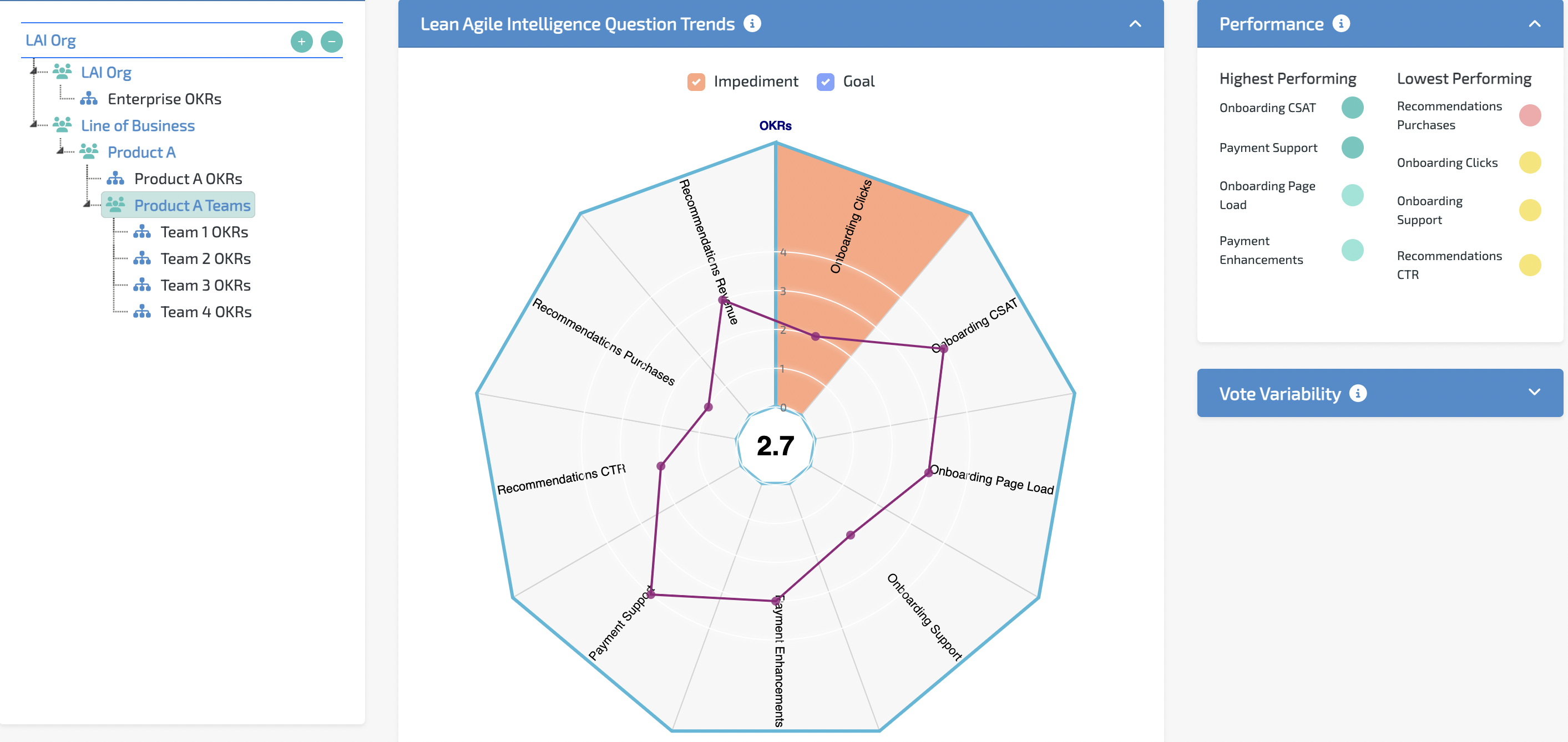
In the dynamic and rapidly evolving world of product development, clear goal-setting and alignment are crucial for achieving success. One of the most powerful frameworks that organizations can utilize to drive this success is Objectives and Key Results (OKRs).
While the concept of OKRs may be familiar, understanding how to effectively scale and align them across multiple levels of an organization can present challenges. In this blog post, we aim to demystify this process by focusing on the cascading approach to OKRs, a proven method that fosters alignment, transparency, and accountability. For a comprehensive understanding of the OKR framework and its impact on organizational success, we recommend exploring our earlier post on the introduction to OKRs. Additionally, we have provided a detailed step-by-step guide on how to set up OKRs in Lean Agile Intelligence, which serves as a valuable resource for organizations seeking to maximize the potential of this goal-setting framework.
The Benefits of a Cascading Approach to OKRs
Cascading OKRs begin with high-level objectives set at the enterprise level that cascade down to lower levels, such as product units and individual teams. This method ensures alignment across the organization, promoting a shared understanding of overarching goals.
A cascading approach to OKRs can profoundly impact an organization's operational efficiency and strategic focus when used effectively. This methodology allows organizations to create a clear and measurable roadmap that aligns every level of the organization to the overall strategy.
-
Alignment: Cascading OKRs ensure alignment at all levels of the organization, from the highest strategic levels down to individual team members. When enterprise-level OKRs are broken down into more specific product and team OKRs, each department, team, and individual can see how their efforts directly contribute to the larger organizational objectives. This alignment ensures everyone is working toward common goals and increases coherence and unity within the organization, breaking down silos and fostering cross-functional collaboration.
-
Transparency: A cascading approach to OKRs inherently promotes transparency. It allows every member of the organization to understand their goals and how they fit into the larger picture. This transparency can improve decision-making at all levels, as everyone clearly understands the organization's strategic objectives and their role in achieving them. Moreover, when team members can see how their work contributes to the overall strategy, it can boost engagement and motivation.
-
Accountability: With clear, measurable key results at each level, the cascading approach fosters accountability. Everyone knows what they need to achieve and how their performance will be measured. This clarity can drive performance as teams and individuals strive to meet their OKRs. It can also encourage proactive problem-solving, as it's clear where responsibility lies for each objective.
-
Focus: By aligning enterprise, product, and team OKRs, and organizations can maintain strategic focus. It can be easy for teams to become sidetracked by day-to-day tasks or emerging issues. However, with cascading OKRs, all efforts can be oriented toward achieving key results that contribute to the broader objectives. This focus can improve productivity and ensure resources are being used effectively.
-
Agility: Cascading OKRs can also enhance an organization's agility. As OKRs are reviewed and updated, adjustments at the top can cascade down through the organization, allowing for rapid, coordinated responses to changing circumstances. This agility is particularly valuable in today's fast-paced, ever-changing business environment.
Below is a visual representation of Cascading OKRs, some of which are presented in the rest of this blog post.
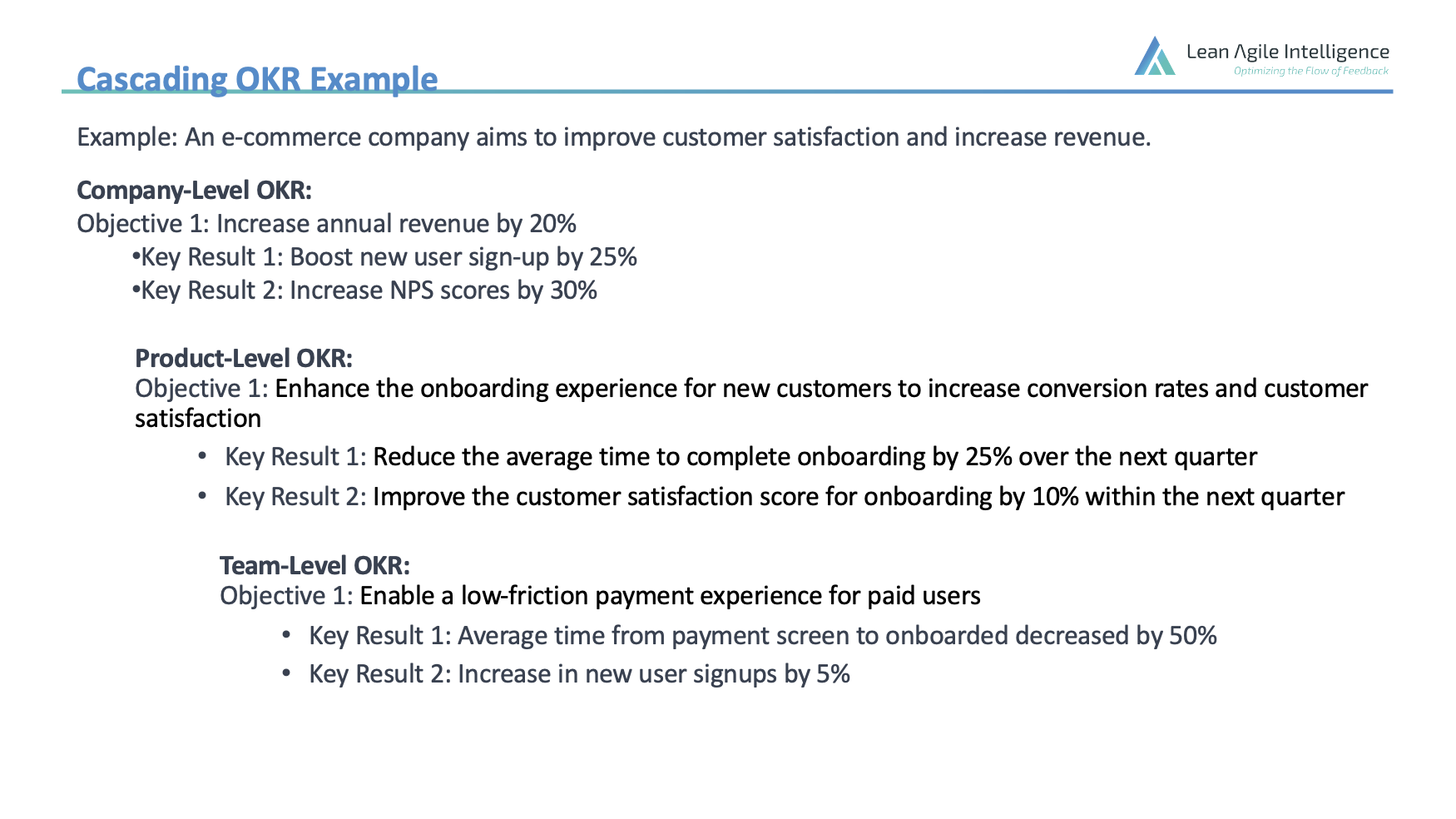
How to Implement a Cascading Approach to OKRs in Product Development
Adopting a cascading approach to OKRs in a product development context involves several key steps, each designed to ensure alignment and focus at every level of the organization.
-
Set enterprise-level OKRs: The first step involves the executive team setting the enterprise-level OKRs. These should encapsulate the broader strategic goals of the entire organization for a defined period. These objectives must be ambitious, actionable, and communicated to all stakeholders.
-
Translate to product-level OKRs: Once the enterprise-level OKRs are established, the next step involves translating these into product-level OKRs. This should be a collaborative process involving product managers, who must interpret the enterprise-level objectives and devise product goals to contribute to their achievement. These product-level OKRs should align with the overall organizational strategy and provide a clear roadmap for the product teams.
-
Break down to team-level OKRs: The product-level OKRs are broken down into team-level OKRs. This step is crucial for ensuring alignment and focus at the ground level. Each team should clearly understand their objectives and how they contribute to the product and enterprise-level goals. Team-level OKRs provide a framework for individual teams to measure their progress and understand their role in the broader strategy.
-
Engage all team members in the process: For a cascading approach to be effective, engaging all team members is crucial. This includes discussing the OKRs in team meetings, encouraging feedback and input, and ensuring each team member understands the OKRs and their role in achieving them.
-
Ensure resources and support: Implementing a cascading approach to OKRs also involves ensuring teams have the necessary resources and support to achieve their goals. This might involve facilitating cross-functional collaboration, providing training or tools, or addressing any obstacles that impede progress.
-
Regularly review and adjust: Lastly, reviewing and adjusting OKRs is essential. Regular check-ins can help keep teams on track and allow for adjustments as necessary, ensuring OKRs remain relevant and achievable.
To set up OKRs in Lean Agile Intelligence, you check out this step-by-step guide. We will discuss tracking and reviewing below.
Tracking OKRs: Ensuring Alignment and Progress
Tracking OKRs should be an ongoing activity, not a one-off event. Regular check-ins (quarterly or more often) can ensure that all teams are on track to their key results. During these updates, teams can share progress, discuss challenges, and solve any roadblocks collaboratively. This continuous tracking ensures alignment, encourages proactive problem-solving, and keeps the focus on the end goals.
To track OKRs in Lean-Agile Intelligence follow these steps:
- Set up the OKRs
- Enter the current key results by taking the assessment.
Example of a Key Result being recorded via LAI Assessment Template.
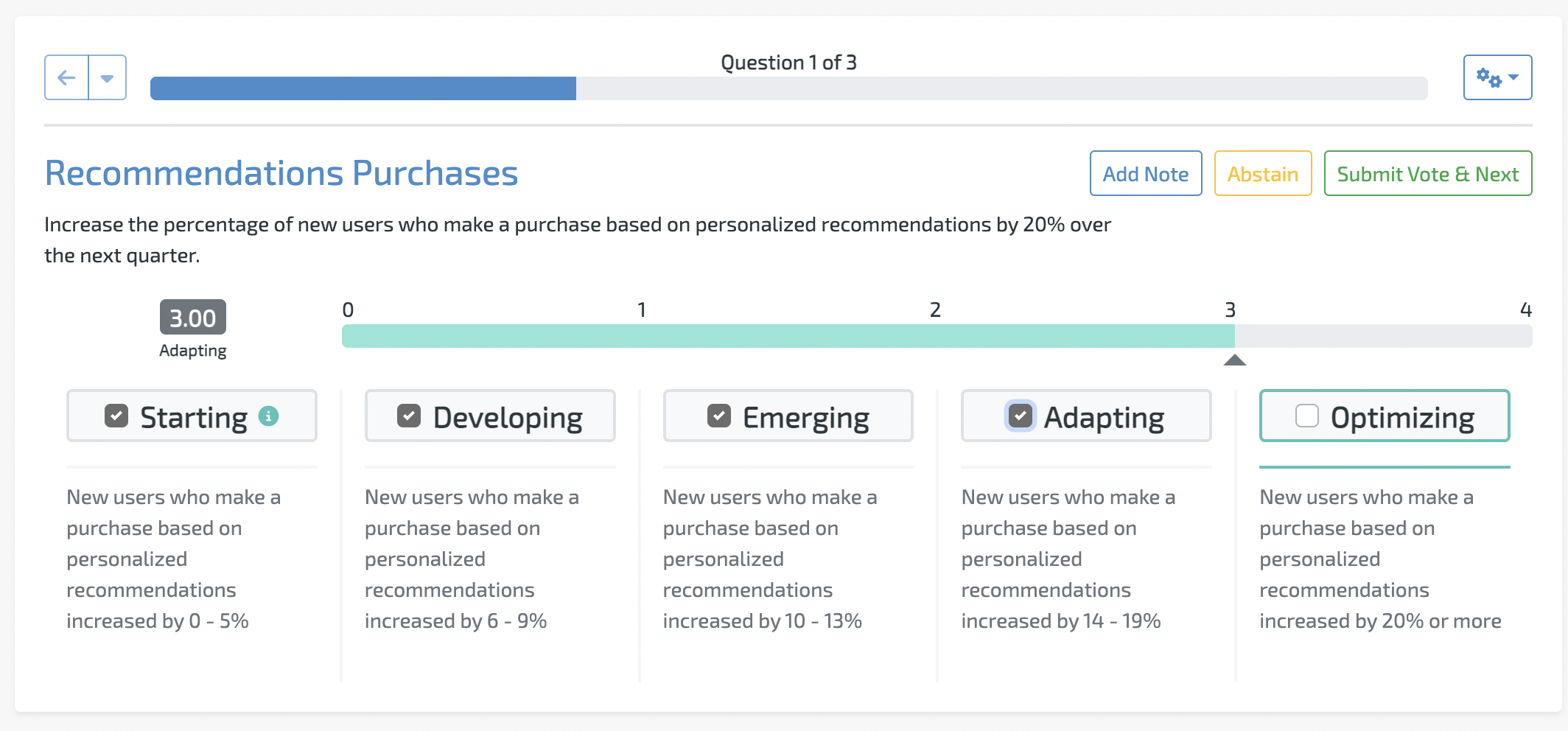
Viewing Results
Let's look at some examples. The images below demonstrate cascading OKRs in the Lean-Agile Intelligence Results Dashboard.
This image shows a roll-up of all OKRs with a view of how the Objectives are currently performing.

Cascading OKRs starting with Enterprise OKRs. The Enterprise Objective is "Increase Annual Revenue by 20%."

For this Objective, The Key Results are defined as leading revenue indicators: "User Signups" and "NPS."
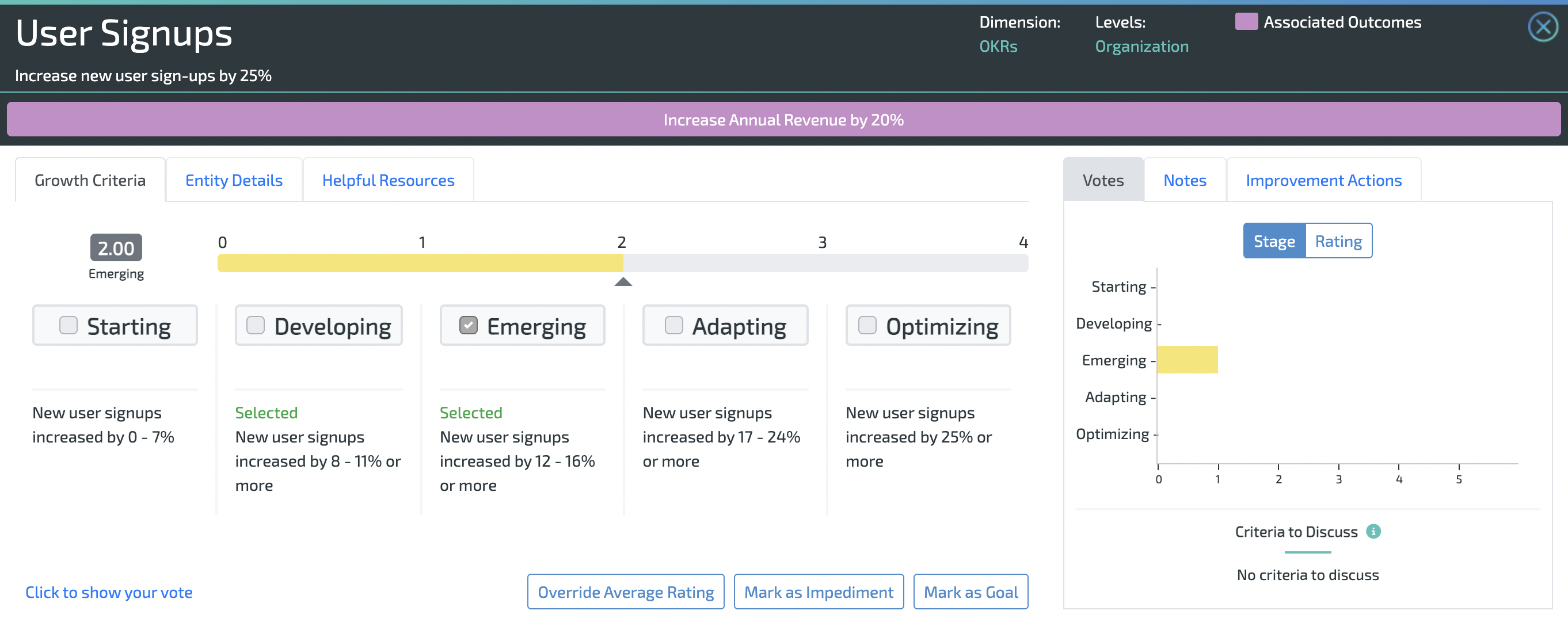
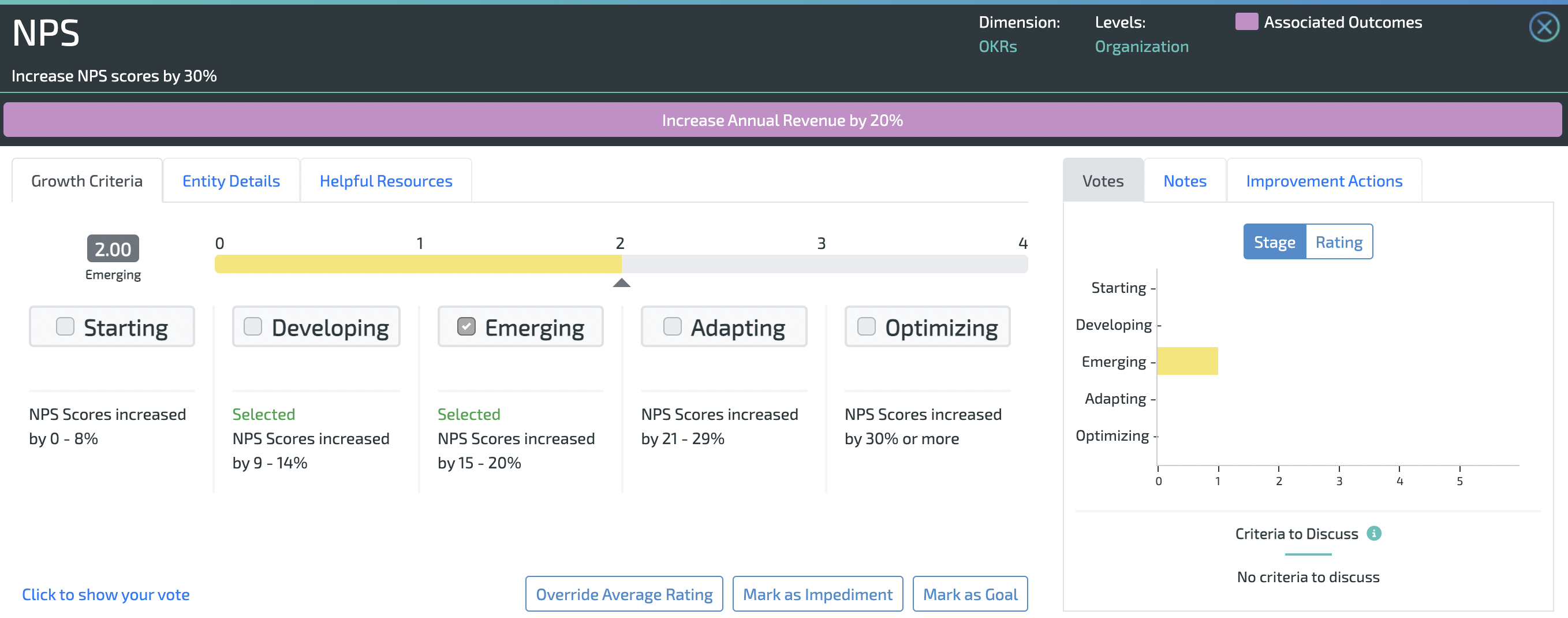
The next level of the cascade is a Product Objective, "Increase customer conversion rate" The details of this objective are "Enhance the onboarding experience for new customers to increase conversion rates and customer satisfaction." This objective helps drive the enterprise's objective of increasing annual revenue by 20%.

The Key Results for this Product Objectives are "Onboarding Enhancements and CSAT onboarding." The "Onboarding Enhancements" Key Result has been marked as a growth goal as it hasn't performed as expected.
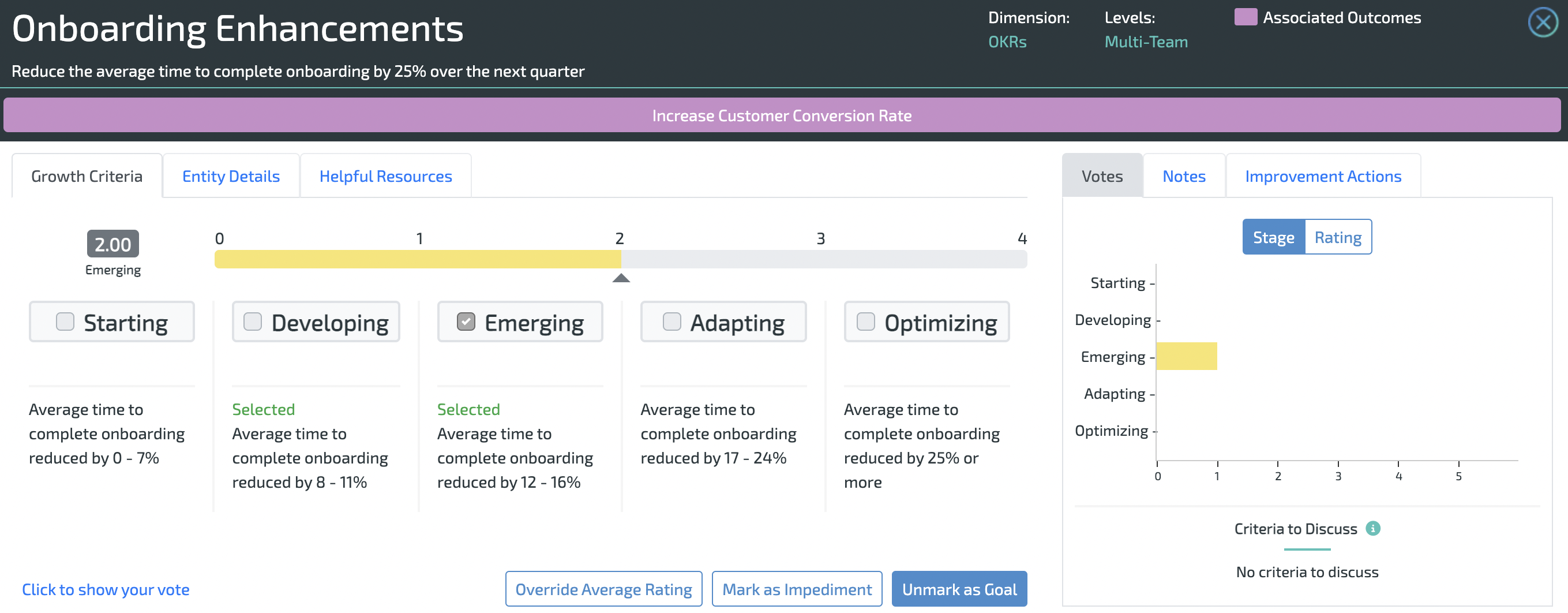
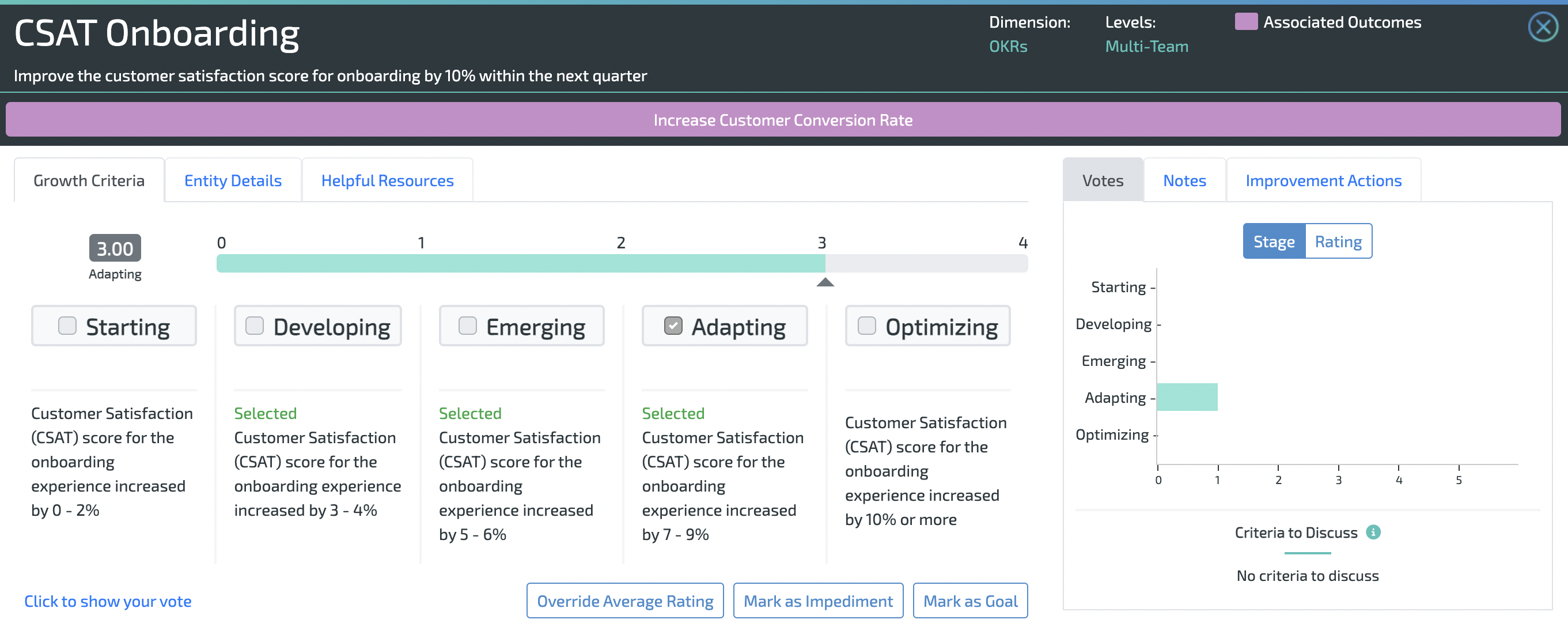
The next level of the cascade is Team Objectives that impact the Product OKRs. Below is a roll-up of all the teams working on Product A. They each have their OKRS that impacts the Product Objectives. The four objectives they are working on are "Low Friction Payment Experience," Reduce Onboarding Friction, "Streamline Onboarding UX," and "Enhance Recommendations During Onboarding."


Here is an example of Team 3, who has an impediment to their OKR. They have created an improvement action.
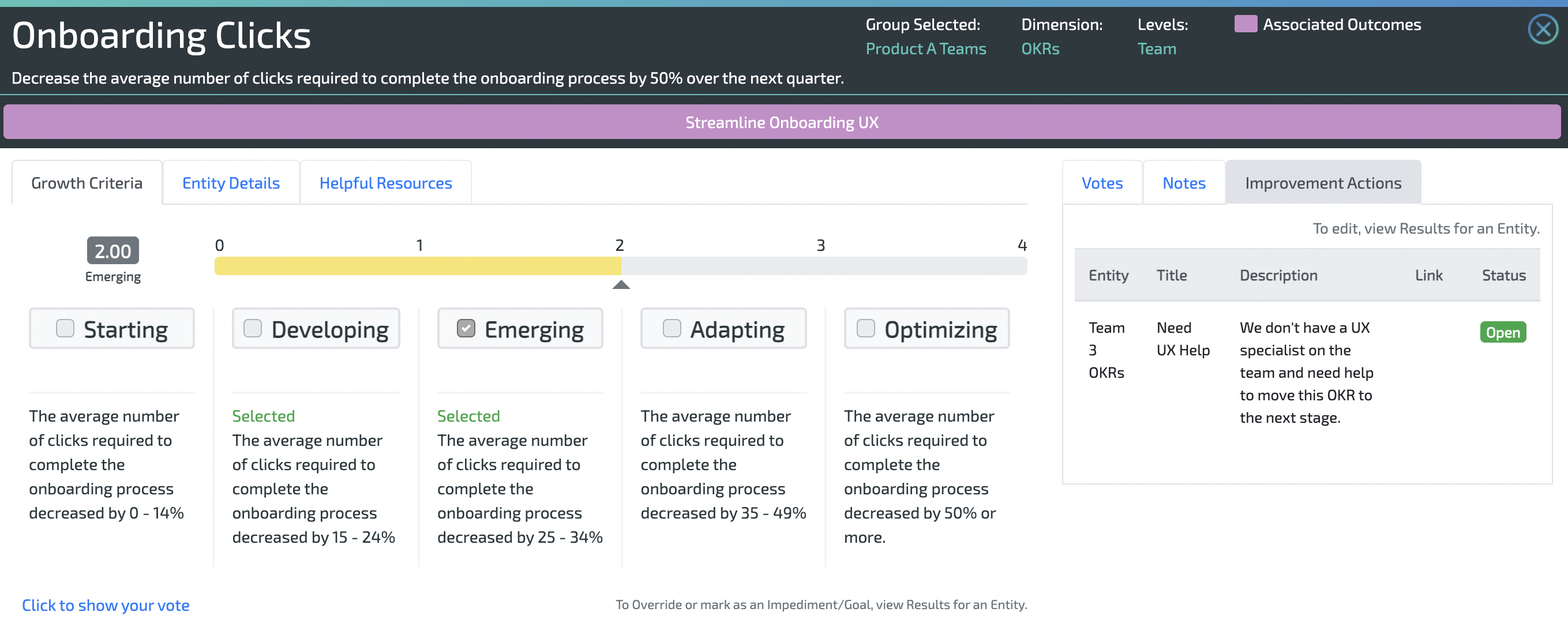
Reviewing OKRs: Maintaining Relevance and Responsiveness
OKRs are not set in stone; they should evolve with the organization's needs and market conditions. Therefore, regular reviews are essential. These sessions provide an opportunity to assess the relevance of the current OKRs, identify gaps, and make adjustments as necessary. Reviews should be seen as a learning opportunity to realign with shifting organizational needs, not as a performance evaluation or blame session.
Setting Goals, Impediments, and Adding Improvement Actions During the Review
LAI allows users to set, create, and maintain goals, impediments, and improvement actions, which can be highly useful for improvement.
During an OKR Review, Go to Results and follow these steps:
- Select the entity you want to review
- Select the OKR you want to review in the dashboard
In the example below entity "Team 2 OKRs" is selected, and the Key Results for "Recommendation Purchases" will be reviewed.
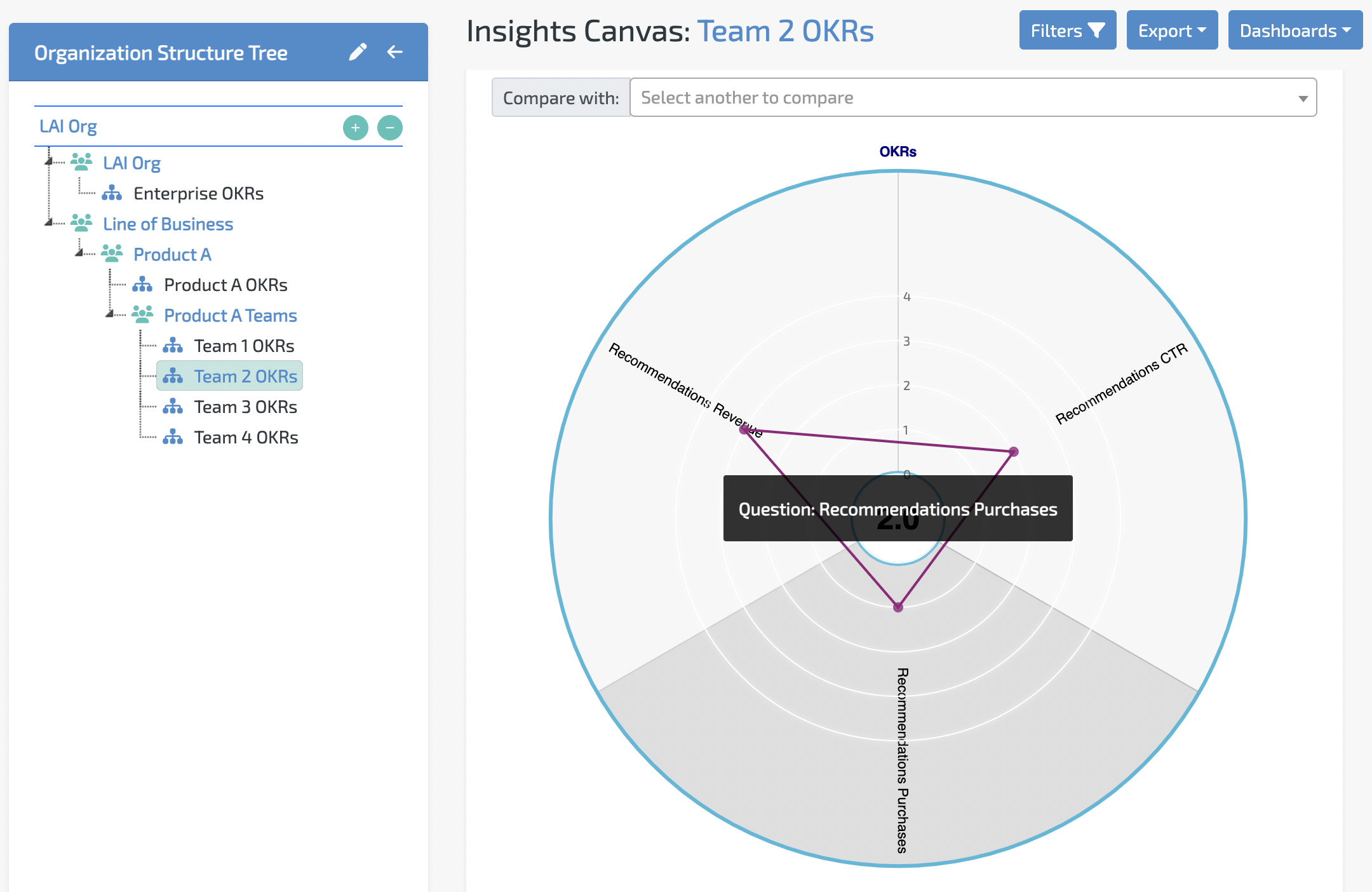
Mark as a "Goal" or "Impediment" if applicable
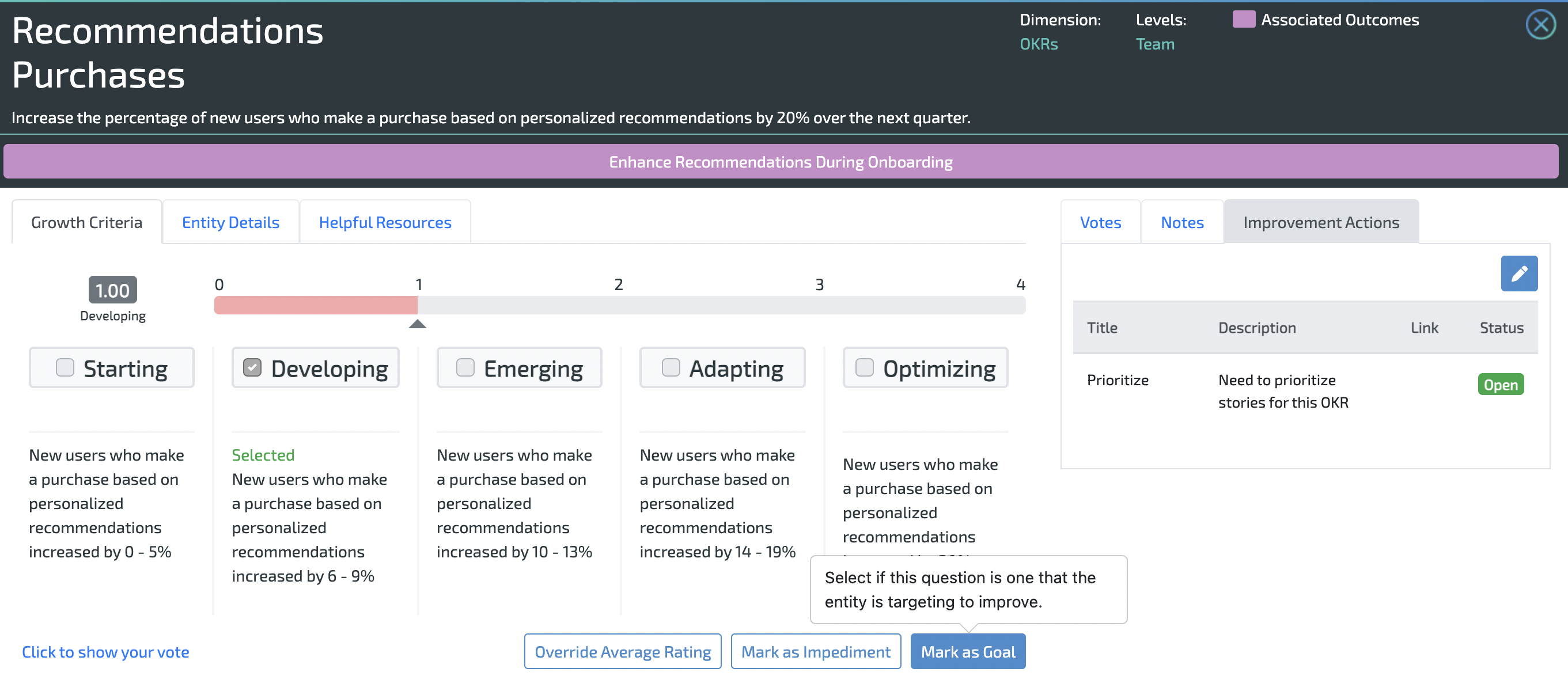
To Add Improvement Actions follow the steps below:
- Select the pencil icon in the top right corner to add a new improvement action.
- Provide a Title for the action.
- Provide a Description
- Provide a Link (optional)
Below is an example of an improvement action related to prioritization, with a link to a blog post with suggestions.

Updating OKRs: Staying Agile in a Changing Landscape
One of the hallmarks of a successful organization is its ability to adapt and pivot in response to a shifting landscape. This agility is crucial in the fast-paced world of product development, where customer needs, market conditions, and competitive landscapes can change rapidly. The OKR framework is designed with this flexibility, allowing organizations to stay nimble and responsive.
When updating OKRs, it's important to approach the process with an open mindset. This is not about admitting failure or acknowledging that initial objectives were misguided. Instead, it's about refining focus based on the most current and accurate information. It's a proactive process that positions the organization to achieve its goals, even as they evolve.
In practice, updating OKRs might involve adjusting key results to reflect a change in strategy or prioritization. For example, if a product development team is launching a new feature but discovers a significant user experience issue in an existing feature, they might pivot to addressing the existing issue first.
Updating OKRs can also involve redefining objectives. If market research reveals that customer preferences are shifting, an organization might redefine its product objectives to meet customer needs better.
A key aspect of updating OKRs is communication. Changes should be transparently communicated across the organization. This ensures that everyone understands why changes are being made, how they impact the broader objectives, and the new expectations. Effective communication mitigates confusion or disorientation from changing goals and maintains alignment across the organization.
Regular check-ins and reviews provide opportunities for OKR updates. These should be conducted at least quarterly, but many organizations find monthly or bi-weekly updates beneficial. The frequency will depend on the nature of the objectives, the rate of change in the market or industry, and the organization's culture and processes.
Ultimately, the key to effectively updating OKRs is to view the process as a tool for promoting agility, responsiveness, and continuous improvement. By regularly revisiting and adjusting OKRs, organizations can ensure that they are always focused on the most important and impactful goals, no matter how much the landscape around them might shift.
Conclusion
A cascading approach to OKRs offers powerful benefits for any organization, particularly those involved in product development. This approach fosters organizational transparency and accountability by ensuring a clear alignment of enterprise to team-level objectives. Furthermore, it enables everyone - from the highest levels of leadership to the individual contributors on a team - to see how their work directly contributes to overarching goals.
Implementing, tracking, reviewing, and updating OKRs may seem complex, but they are crucial in making the most of this strategic framework. Implementing cascading OKRs requires thoughtful planning, open communication, and a commitment to ongoing review and adjustment. But the payoff - regarding organizational alignment, clear goal setting, and increased transparency and accountability - is well worth the effort.
As your organization scales, so too should your approach to OKRs. Adopting a cascading methodology enables you to ensure that everyone is pulling in the same direction, no matter how large or complex your operations become. So, take the leap, cascade your OKRs, and watch your product development efforts succeed with Lean Agile Intelligence!